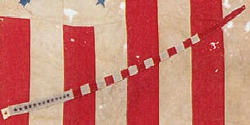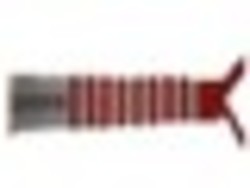

Catalog Photo

Book Photo

Obverse


U.S. 13 Stars Revenue Service Pennant.
Sub-collection: Mastai - Early American Flags13 Star U.S. Revenue Cutter Service commissioning pennant.
The Act of March 2, 1799, known as the Customs Administration Act authorized that "the cutters and boats employed in the service of the revenue shall be distinguished from other vessels by "an ensign and pendant, with such marks thereon as shall be prescribed and directed by the President of the United States."
Oliver Wolcott, Alexander Hamilton's successor as Secretary of the Treasury in 1795, was given the honor of conceiving a new ensign. On June 1, 1799, Wolcott presented his design to President John Adams for approval. Wolcott's concept was an ensign of sixteen vertical stripes, alternating red and white, corresponding to the number of states comprising the Union by 1799. Wolcott was following the stipulations of Congress, which, in 1794, had already modified the national flag to fifteen stars on fifteen stripes, providing for an amendment to the design at the entry of each new state. Wolcott increased the stripes to sixteen, and altered their display to be perpendicular to the horizontal lines of the U.S. Flag.
This new flag was ultimately implemented August 1, 1799, when Secretary of the Treasury, Oliver Wolcott, issued an order announcing that in pursuance of authority from the President, the distinguishing ensign and pennant would consist of, "16 perpendicular stripes, alternate red and white, the union of the ensign to be the arms of the United States in a dark blue on a white field."
We assume that the Commission Pennant, like the ensign reflected the 16 states of the Union, was adopted at the same time. Traditionally, masthead pennants were flown from a nation's warship. This type of flag is also called by such various names as a commissioning, masthead, and a long, narrow, or coach whip pennant. Customarily, these pennants were used primarily on public vessels of sovereign states. In 1674, Britain had limited these pennants to use on the King's ships. Presently, such pennants serve as the "distinctive mark" stipulated in Article 8 of the "1958 Convention on the High Seas," by which to distinguish warships from other vessels.
The commission pennant is a characteristic marking for commissioned Coast Guard cutters; vessels commanded by commissioned or warrant officers. Its raising symbolizes the commissioning new ships and from that time onward, until the ship is decommissioned, the pennant is flown perpetually from the aftermost masthead, except for instances when the cutter is flying an admiral's flag or a command pennant. The commission pennant is also used to indicate the company of a commanding officer (admirals, etc.) and is otherwise used for all the same purposes served by its US Navy equivalent.
Before the Civil War, Revenue Marine cutters were already using a commission pennant that was white with 13 blue stars at the hoist with red and white vertical stripes taking up the fly. After the war, it modified to a design similar to what the US Navy used at the time. This version entailed 13 white stars on blue at the hoist, with the tail striped vertically as before as opposed to that of the Navy, which had red over white. However, in 1938, the Coast Guard, successor to the Revenue Marine and Revenue Cutter Service, reinstated the old antebellum pennant, which we still see in use today.
This small pennant probably dates from after 1938 due to the presence of zigzag stitching on the pennant.
Exhibition History:
First Presidio Exhibit
(ZFC0637)
United States Revenue Service Commision Pennant
Second Presidio Exhibit Gallery One Copy 2003
ZFC0637
13-Star, 16-Stripe United States Revenue Cutter Service Pennant
Publication History:
Madaus, Howard M., Dr, Whitney Smith, The American Flag: Two Centuries of Concord and Conflict. Santa Cruz: VZ Publications, 2006, p. 31.
Provenance: Acquired by the Zaricor Flag Collection (ZFC0637) in 2002 from the Mastai Flag Collection of New York City through auction at Sotheby's.
ZFC Significant Flag
Item is Framed
Sources:
Madaus, Howard M.- Whitney Smith, The American Flag: Two Centuries of Concord and Conflict, VZ Publications, Santa Cruz, 2006.
Mastai, Boleslaw and Marie-Louise D'Otrange, The Stars and The Stripes: The American Flag as Art and as History from the Birth of the republic to the Present, Knopf, New York, 1973.
Preble, George Henry, The History of the Flag of the United States of America, Boston, Houghton, Mifflin & Co. 1894.
Saba, Anne, January 2000, Tradition, Service, Honor - The Customs Ensign, Customs Today, 1 November 2011, from:
http://www.cbp.gov/custoday/jan2000/tradtn.htm
Flag Day: CBP's Ensign Was America's First For Government Agency, 1 November 2011, http://www.cbp.gov/xp/cgov/newsroom/highlights/flag_day.xml
United States Customs Service. Wikipedia, 1 November 2011, from:
http://en.wikipedia.org/wiki/United_States_Customs_Service
Flags, Logos, Pennants, Seals & Streamers Of the Coast Guard & Its Predecessor Services, United states Coast Guard, 1 November 2011, from:
http://www.uscg.mil/history/articles/Coast_Guard_Flags.asp
Image Credits:
Zaricor Flag Collection.
Hoist & Fly | |
|---|---|
| Width of Hoist | 2 |
| Length of Fly | 60 |
Stars | |
|---|---|
| Comments on Star Measurements | 13 stars in a horizontal row. |
Stripes | |
|---|---|
| Size of Hoist | 2 |
Frame | |
|---|---|
| Is it framed? | yes |
| Frame Height | 72.5 |
| Frame Length | 6 |
Stars | |
|---|---|
| Number of Stars | 13 |
| Are there stars on obverse? | yes |
| Are there stars on reverse? | yes |
Stripes | |
|---|---|
| Number of Stripes | 16 |
| Color of Top Stripe | Red |
| Color of Bottom Stripe | White |
| Has a Blood Stripe? | no |
Nationality | |
|---|---|
| Nation Represented | United States |
Fabric | |
|---|---|
| Fabric | Wool |
Stitching | |
|---|---|
| Stitching | Machine |
Weave | |
|---|---|
| Type of Weave | Plain |
Attachment | |
|---|---|
| Method of Attachment | Headings & Grommets |
Applica | |
|---|---|
| Applique Sides | Single Faced = Mirror Image Reverse |
Documentation | |
|---|---|
| Documents |
All original documents and drawings are held in the Zaricor Flag Collection Archives.
|
| Drawings |
All original documents and drawings are held in the Zaricor Flag Collection Archives.
|
| Research Documents |
All original documents and drawings are held in the Zaricor Flag Collection Archives.
|
| Public Copy & Signs | |
Condition | |
|---|---|
| Condition | Good |
| Damage | Used |
| Displayable | yes |
Date |
|---|
Exhibits | |
|---|---|
| Exhibition Copy | First Presidio Exhibit (ZFC0637) United States Revenue Service Commision Pennant Date: About 1868-1882 Medium: Printed wool bunting; machine sewn Comment: Like the U.S. Navy, the Revenue Service issued a commission pennant to be flown so long as the vessel was in government service. This printed, sixteen-stripe pennant bears the figure 6 on its heading, indicating its length as 6 feet. Provenance: Acquired by the Zaricor Flag Collection (ZFC0637) in 2002 from the Mastai Flag Collection of New York City through auction at Sotheby's. Second Presidio Exhibit Gallery One Copy 2003 ZFC0637 13-Star, 16-Stripe United States Revenue Cutter Service Pennant Date: About 1870-1880 Media: Stripes and canton with stars all resist-dyed on wool bunting Comment: On March 1, 1799, Congress authorized cutters and boats employed in the service of the revenue for the United States Treasury Department to fly a distinctive ensign and pennant. On August 1st that year, the Secretary of the Treasury defined those flags. The ensign and pennant each consisted of 16 vertical stripes alternately red and white, while the union of the ensign bore the arms of the United States in dark blue on a white field. Until 1915 this distinctive flag identified those U.S. ships and buildings associated with Customs and the Revenue Cutter Service; after 1915 the same flag with the addition of the Coast Guard emblem on the stripes was flown by the Revenue Cutter Services successor, the United States Coast Guard. Provenance: Acquired by the Zaricor Flag Collection (ZFC0637) in 2002 from the Mastai Flag Collection through auction at Sotheby's of New York City. |
Publications | |
|---|---|
| Publication Copy | Madaus, Howard M., Dr, Whitney Smith, The American Flag: Two Centuries of Concord and Conflict. Santa Cruz: VZ Publications, 2006, p. 31. United States Revenue Cutter Service Pennant On March 2nd, 1799, Congress authorized cutters and boats employed in the service of the revenue for the United States Treasury Department to fly a distinctive ensign and masthead pennant. On August 1st of that year, the Secretary of the Treasury defined those flags: The ensign and pendant consists of sixteen perpendicular stripes alternate red and white, the union of the ensign bearing the arms of the United States in dark blue on a white field. Until 1915, flags of this style identified those U.S. ships engaged on customs and revenue service; after 1915 the same flag with the addition of the Coast Guard insignia on the stripes was flown by the Revenue Cutter Services successor, the United States Coast Guard. The Customs Service continues to use a modernized version of this flag. When the Revenue Cutter Service flags were adopted, sixteen states comprised the Union. Although Ohio became the seventeenth state in 1803, no change was made in the Revenue Service flags. Nevertheless, the utilization of sixteen stripes reflects the pervading concept that the number of stripes be increased with every addition of a new state. The Indian Department, then a branch of the War Department, also adopted a distinctive flag with the coat of arms of the U.S. in its canton. Date: About 1890s Size: 2" hoist x 60" fly Medium: Wool bunting; press dyed Provenance: Flag acquired by the Zaricor Flag Collection in 2002 from the Mastai Flag Collection through auction at Sotheby's of New York City. ZFC0637 |


